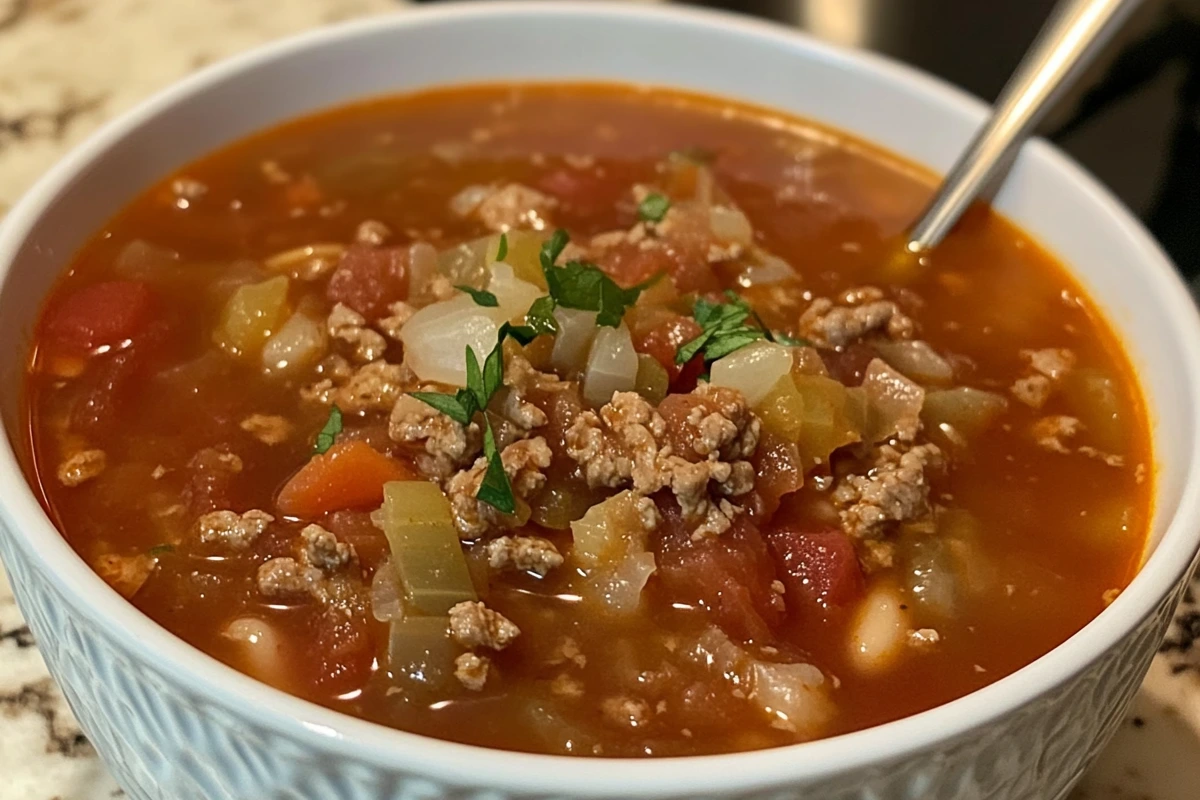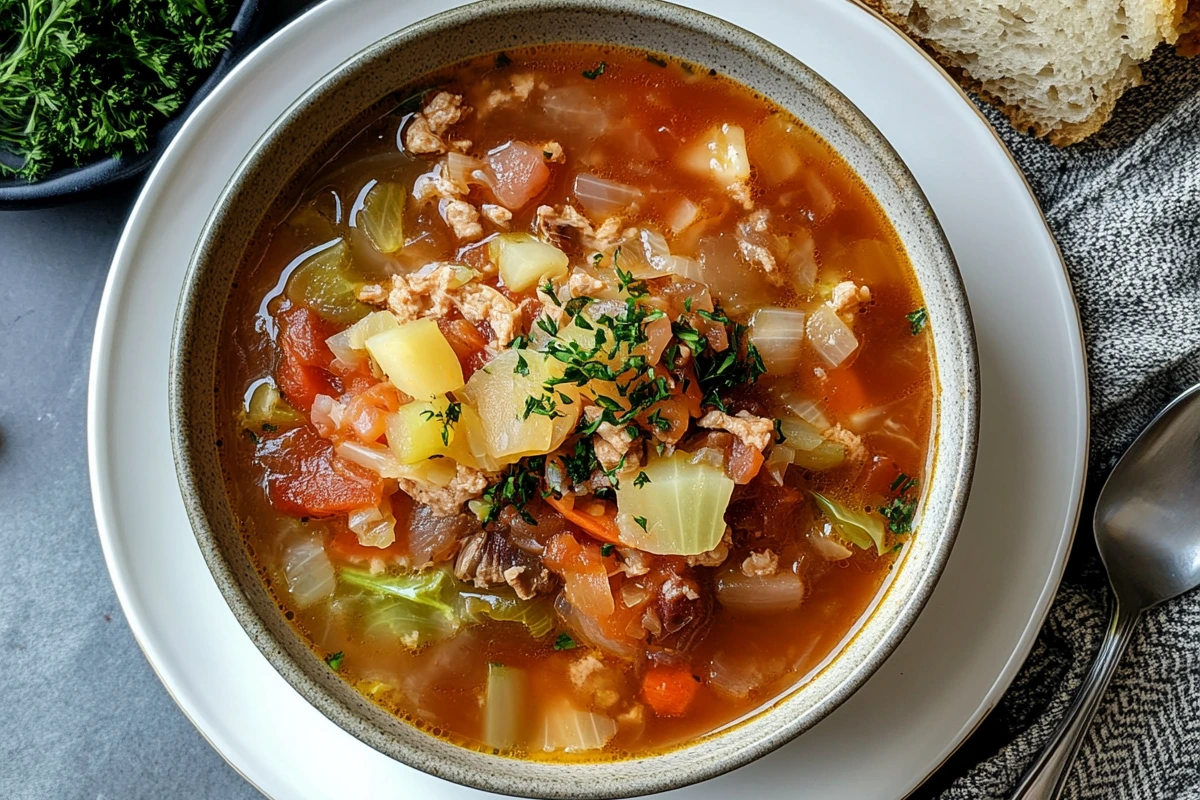
Introduction
Cabbage Soup Recipe is a comforting, versatile, and nutritious dish loved by people worldwide. Known for its simplicity and wholesome ingredients, it’s an ideal meal for those looking to enjoy a delicious, low-calorie dish without compromising on flavor. Whether you’re seeking a filling lunch, a detox meal, or just a tasty way to use up extra vegetables, cabbage soup has it all. With roots dating back to various cultures, cabbage soup is often associated with weight-loss diets due to its low-calorie content and high nutritional value. Let’s explore this beloved recipe’s history, ingredients, variations, and more!
History of Cabbage Soup Recipe
The origin of cabbage soup can be traced back to humble beginnings in Eastern European and Russian cuisine, where it was known as “shchi.” This soup became a staple in peasant diets, given its affordability and ability to be prepared in large batches. In other parts of the world, cabbage soup variations evolved, including Korea’s spicy “kimchi jjigae” and Germany’s hearty “krautsuppe.”
In recent times, the “Cabbage Soup Diet” gained popularity as a quick weight-loss method. This diet claims to help shed pounds rapidly by relying heavily on cabbage soup’s low-calorie content. While the diet itself has faced some criticism, the soup remains a favorite for its health benefits, rich flavor, and satisfying warmth.
Ingredients of Cabbage Soup Recipe
Essential Ingredients:
- 1 medium head of green cabbage, chopped
- 1 large onion, diced
- 2 carrots, sliced
- 2 celery stalks, chopped
- 2 garlic cloves, minced
- 1 large bell pepper, chopped
- 1 can (14 oz) diced tomatoes (with juice)
- 6 cups vegetable broth (or chicken broth)
- 1 tbsp olive oil
- 1 tbsp tomato paste
- 1 tsp dried thyme
- 1 tsp dried oregano
- 1 bay leaf
- Salt and pepper, to taste
Substitutions & Dietary Options:
- For low-carb diets: Replace carrots with zucchini or mushrooms.
- For added protein: Add cooked chicken, turkey, or beans (like chickpeas or kidney beans).
- For a spicy kick: Add chopped jalapeño or cayenne pepper.
- For vegetarian/vegan options: Stick to vegetable broth and add tofu or plant-based protein.
Cooking Instructions
1: Prepare the Vegetables
- Wash all vegetables thoroughly.
- Chop cabbage into bite-sized pieces, dice onions, slice carrots and celery, and mince garlic.
2: Sauté the Vegetables
- Heat olive oil in a large pot over medium heat.
- Add onions, garlic, carrots, and celery, and sauté for about 5-7 minutes until softened.
3: Add the Cabbage & Broth
- Add chopped cabbage, bell pepper, and diced tomatoes (with juice).
- Mix in the tomato paste, dried thyme, oregano, and bay leaf.
- Add the vegetable broth and bring the mixture to a rolling boil.
4: Simmer
- Once boiling, reduce heat to low and let the soup simmer for 30-40 minutes.
- Stir occasionally and season with salt and pepper to taste.
5: Serve & Enjoy
- Remove the bay leaf before serving.
- Ladle the hot cabbage soup into bowls and enjoy with crusty bread or a fresh salad.
Variations
1. Hearty Beef Cabbage Soup:
Add browned ground beef or sausage to the soup for a more filling, meaty version.
2. Spicy Kimchi Cabbage Soup:
Replace diced tomatoes with kimchi, add gochujang (Korean chili paste), and increase garlic for a spicy kick.
3. Creamy Cabbage Soup:
Add a splash of coconut milk or cream to the soup for a richer, creamier texture.
4. Detox Cabbage Soup:
Make a lighter version with more green veggies like kale, spinach, and green beans, reducing the sodium content.
5. Italian Cabbage Soup:
Add Italian herbs, white beans, and a handful of pasta or orzo for an Italian twist.

Storage and Reheating Tips
Storing Leftovers
- Refrigeration: Allow the soup to cool, then transfer it to an airtight container. It can be stored in the refrigerator for up to 5 days.
- Freezing: Cabbage soup freezes well. Divide it into freezer-safe containers or bags and store in the freezer for up to 3 months.
Reheating
- On the Stove: Reheat the soup over medium heat until warmed through, stirring occasionally.
- In the Microwave: Use a microwave-safe bowl, cover it, and heat in 1-2 minute intervals, stirring between intervals.
Serving Suggestions
- With Bread: Serve cabbage soup with warm crusty bread, garlic bread, or even a slice of sourdough.
- With a Salad: Pair it with a fresh green salad or coleslaw for a light meal.
- As a Side Dish: Enjoy cabbage soup as a side with grilled meats, sausages, or hearty sandwiches.
Health Benefits of Cabbage Soup
Cabbage soup isn’t just flavorful; it’s packed with health benefits that make it a fantastic addition to any diet:
1. Low in Calories, High in Nutrients
Cabbage is naturally low in calories but rich in essential nutrients like vitamins C, K, and B6, as well as folate, calcium, and potassium. The soup’s low-calorie profile makes it an excellent choice for those looking to maintain or lose weight while still enjoying a satisfying meal.
2. High in Fiber
Cabbage is an excellent source of dietary fiber, which aids digestion and promotes a feeling of fullness. The fiber in this soup helps regulate blood sugar levels, supports gut health, and may even lower cholesterol.
3. Rich in Antioxidants
Cabbage is loaded with antioxidants, including polyphenols and sulfur compounds, which help protect cells from damage caused by free radicals. Antioxidants can reduce inflammation and support overall health, contributing to a stronger immune system.
4. Promotes Heart Health
The potassium content in cabbage soup is beneficial for heart health. Potassium aids in regulating blood pressure, which helps lower the risk of developing hypertension. Additionally, the fiber and antioxidants present may help lower cholesterol levels, further supporting cardiovascular well-being.
5. Detoxifying Properties
Cabbage contains compounds like glucosinolates, which support the liver’s natural detoxification process. Including cabbage soup in your diet can promote the body’s natural ability to eliminate toxins, aiding in overall detoxification.
6. Supports Weight Loss Goals
Cabbage soup is filling yet low in calories, making it a popular choice for weight management. It keeps you full longer, reducing the temptation to snack or overeat, making it ideal for a balanced, weight-conscious diet.
FAQs
1. Is cabbage soup good for weight loss?
Yes, cabbage soup is low in calories and high in fiber, making it a great option for those aiming to lose weight. It can be part of a balanced diet, but it’s best to enjoy it with a variety of other foods for optimal nutrition.
2. How can I make cabbage soup taste better?
Adding spices like cumin, paprika, or a splash of vinegar can enhance the flavor. You can also add a dollop of sour cream or shredded cheese on top for extra richness.
3. Can I use red cabbage instead of green cabbage?
Yes, red cabbage works well too! It will add a slightly different flavor and a vibrant color to the soup.
4. Is cabbage soup keto-friendly?
Yes, it can be keto-friendly if you avoid high-carb veggies like carrots and potatoes. Substitute with low-carb vegetables such as mushrooms, spinach, or zucchini.
5. What’s the best way to thicken cabbage soup?
Add a few tablespoons of tomato paste, or let the soup simmer longer to reduce the liquid and enhance thickness. You can also mash some of the vegetables for a thicker texture.
Conclusion of Cabbage Soup Recipe
Cabbage soup is a timeless recipe that combines wholesome ingredients, versatility, and ease of preparation. Whether you enjoy it as part of a weight-loss plan, a detox regimen, or simply for its comforting flavors, cabbage soup is a must-try dish that can be customized to suit any taste preference. Try making this delicious soup today and enjoy a bowl of warmth and nutrition!
Pro Tips
- Add fresh herbs like parsley, dill, or cilantro at the end for a burst of flavor.
- If you like a tangy touch, add a splash of apple cider vinegar or lemon juice before serving.

